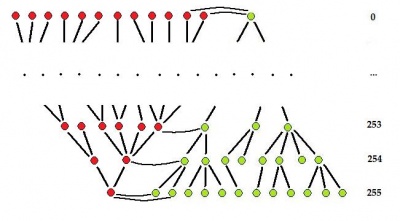This site is devoted to mathematics and its applications. Created and run by Peter Saveliev.
Mathematics of computer vision: course
From Intelligent Perception
1 Description
This is an introduction into the mathematics of computer vision and digital image analysis: topology and geometry. (For a more advanced approach see Introductory algebraic topology: course, more math here.)
The exposition is geared towards CS students and potential and current math majors. The material is self-contained beyond high school math (no calculus). Special attention is paid to the algorithmic implementation of the mathematics. A variety of applications is considered in detail.
2 Prerequisites
Calculus I, computer language preferred but not required.
3 Lectures
A large part of the lectures is now a part of a draft of a book called Topology Illustrated.
Introduction: analysis of visual information and Examples of image analysis
- Digital images
- Raster representation of images: binary, gray scale, and color
- Basics of image processing: noise, blur, contrast, sharpness etc
- Available software (MS Paint, Photoshop, ImageJ, MATLAB, CHomP, jPlex, Pixcavator)
- Topology and geometry of binary images
- Cell decomposition of images
- Detection of objects (connected components)
- Digital measuring and the main geometric characteristics of objects: area, perimeter, roundness, centroid, etc
- Applications
- Topology and geometry of gray scale images
- Thresholding and detection of objects
- Graph representation of the topology - the topology graph
- More digital measuring and characteristics of objects: intensity, center of mass, standard deviation, etc
- Applications
- 3D image analysis
- Miscellaneous topics
- Motion tracking
- Other image segmentation methods
- Stereo vision
- Fourier transform
- Analysis of color images and other multi-parameter images
- Robustness of image analysis
- Robustness under image transformations: noise, blur, translation, rotation
- Robustness of topology under dilation and erosion
- Robustness of geometry under dilation and erosion
4 Review
- What is the difference between binary and gray scale images?
- How do you count holes in a binary image?
5 Projects
C++, Java, or MATLAB
- Modification of the algorithms (construction of the topology graph, analysis of the topology graph);
- Implementation of the algorithms (motion, color, stereo, 3D, etc);
- Practical applications of the algorithms (based on Pixcavator SDK or CHomP).
6 Notes
Software: Pixcavator Student Edition (free)
This page can also be reached by typing CVmath.com or mathCV.com.
Digital discoveries
- Casinos Not On Gamstop
- Non Gamstop Casinos
- Casino Not On Gamstop
- Casino Not On Gamstop
- Non Gamstop Casinos UK
- Casino Sites Not On Gamstop
- Siti Non Aams
- Non Gamstop Casinos UK
- UK Casino Not On Gamstop
- Non Gamstop Casino UK
- UK Casinos Not On Gamstop
- UK Casino Not On Gamstop
- Non Gamstop Casino UK
- Non Gamstop Casinos
- Non Gamstop Casino Sites UK
- Best Non Gamstop Casinos
- Casino Sites Not On Gamstop
- Casino En Ligne Fiable
- UK Online Casinos Not On Gamstop
- Online Betting Sites UK
- Meilleur Site Casino En Ligne
- Migliori Casino Non Aams
